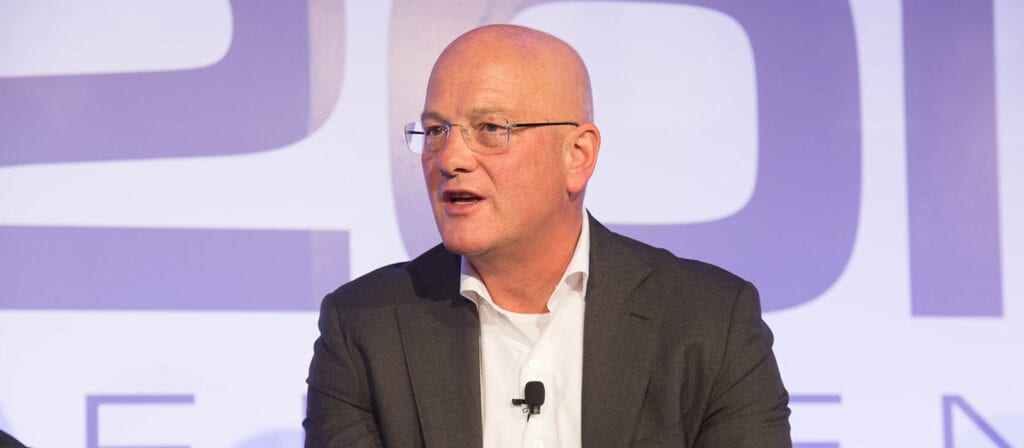Ben Telfer:
Hello everyone, welcome to the ICMIF webinar, episode 9 in our Digital Mutual webinar series. Today we feature the case study of Achmea from the Netherlands and how Achmea is becoming a data-driven digital insurer to enhance value for customers.
I’m very pleased to welcome, from Achmea, Dimitri Van Dyck, Director of Strategy and IT Governance. We also have Jeroen van dem Assem, Business Information Manager. And last but not least, we have Henk Vlessert, who is a Corporate Strategist. Dimitri, I think I’m handing over to you first, welcome and thank you for joining us.
Dimitri Van Dyck:
Hello everybody, my name is Dimitri Van Dyck. I’m within Achmea, responsible for the strategy and IT governance department or even IT organization. And I’m very happy to give you the insight in what we did so far to become a digital data-driven insurance company. I have to be more specific what we did and are still doing, in the coming period, to become so.
For those who don’t know Achmea, we are founded more than 200 years ago, based on the same fundamentals. In fact, that’s what we’re still working on and the fact that we are in heart, based on solidarity. Solidarity in society and that’s where we live from and we live for already, for more than 200 years. And I think it’s a great basis to dwell on further also in our digital ambition that we have. So we are mainly a Dutch company and in the Netherlands, we are far more the most important insurer for a couple of product lines.
But as you see on this map, we have also some foreign activities in Europe. Also in Canada, Australia, we launched a couple of years ago, borne activities. Our organization is organized along five value change, health, no-life, retirement services and international activity and pension life. And what you see on the right-hand side, we have a couple of commercial brands all related towards those value change. And although we’re already in ’21, the figures of 2020 are not yet released, but here you can see that we are a stable organization. And in 2019, we had a big increase in our solvency. So our starting position in 2021 is very well.
2020 was also the start of the new strategic period of our company and the board express the strategy as you can see here, we want to act as the sum of us to build further on the corporate organization that’s relevant to customer and create value for society with health, safe and future proof as key cornerstones to create good health closer to everyone and we’ve covered. We all know what that means. Clean, safe, and smart mobility, safe and sustainable home and living environments, carefree enterprise and good employment practices, have financial services for now, tomorrow, and later.
Having said that, that’s our business strategy, if you see what we have done on IT side from the company to enable that situation very well now, and that we will do further in enabling of our strategy, I will try to give you a flavour on what we did and what we were doing in that direction. In fact, if you see since 2009-2010, our strategy was aligned to the business strategy where you see that we are from origin, the merger organization as Achmea and together in the beginning of period of that last decade, we start with the house of initiatives from a business perspective and IT interpretation was that we would want to have our basics in place. And basic was starting from the very basic part of the IT organization within the infrastructure domain.
The next period was exploration in the innovation period of the company and there we built the IT perspective, the integrated insurer to make as much as possible, reuse of the existing ID for the different product lines and in delivering together or act together, the new strategic period. We focus now on what we need to do to become a real digital insurer. And every three or four years, we do an in-depth analysis on our external environments to see how our strategy fits.
But also in your company, you see that everything goes faster. And by the beginning of the strategic period which is launched in 2020, we said that we see that the blowing market boundaries of… In fact, the boundaries of technology are blurring due to the more technology possibly given by the technology partners. There’s a big trend on democratization of information technology. And not only because everybody thinks that if you have a smartphone, you are an IT professional, but also by using devices like these. Everybody is aware that data is getting more and more important. And we see that is, like we say in the company, there is no trust if there is no good use of data.
And we see the big increase of the technology platforms and the cloud providers. And not only the Microsoft’s, the Google’s, the Apples’ companies, but we see that everywhere. Having said that, we said that what do we need to do to enable effect our business to fulfil the strategic ambition of the company? And that’s what we see here. We have five pillars in our digital strategy and it’s cloud first, data first. In fact, we want to apply the technology. The way of working is important and we focus a lot on people in organization so that on those five pillars, we can build then enable IT to give the trusted IT to the Achmea organization, to give the capability to build the services and product for our customers and our partners in the society.
And that not only on individual scale for each of the product lines together in certainly Dutch organization, but more and more also with our international partners in the international part of our organization. So this is our direction. And the main element of our thinking is now that we want to empower based on the technology, empower our business to deliver the digital services to our customers. And that’s what you have in the one, two, three on the sheet, very high summary level.
But we see that our first element, we process data in real time and fast time, right? That’s a cornerstone based on the data. We build information to turn the real time data into real time relevant information. And based on that, we will work digitally because when you have your data online and on the data you have your information, then you can build on this information and deliver the real value in services or in product fulfilment to your customers.
What do we see as one of our key element in enabling IT? In fact, it’s very simple. Expressed on the sheet, we have fast technology infrastructure where we say that we have in hybrid cloud, public and on-prem plant on that infrastructure, we have our IT services. As a kind of platform, that’s what we call a technology platform and on that technology platform, we have the capability to build digital value streams. So on a joint hybrid infrastructure, a common insurance technology platform on that technology platform, we build digital value for our customers and partners in the society. And that’s in fact, the key message in our strategy that the three elements together is what we build to enable our business.
So, as I already said, we have the five strategic themes and I will dwell a little bit on each of those themes. Cloud first, it’s a key message and now strategy. And cloud first, why we express it as the first element is mainly in the thinking of our IT staff. We wanted everybody to start thinking as if the cloud is the way that we all… We work a real work for the future. So our mental model of each of the employee and members has to start thinking from a cloud perspective.
Although, we are also still on-prem data centre, but the on-prem data centre as part of the hybrid data centre is, or will be managed as if it was a public cloud service. And our preferred public cloud service is Microsoft because in the Dutch situation, it’s on this moment, the most trusted cloud for the financial industry. But in the coming year, we will, next to Microsoft, also see how we can for instance, have Google as second cloud because we want to have the next evolutions also in place that we can work in a really multi-hybrid cloud situation. Therefore, [inaudible 00:13:58], automation and digitalization for our IT management is key because it’s independable of which of our locations that we distribute our technology from.
The second cornerstone is also mentioned with the label or labelled with the element first, is data first. We strongly believe that if you really want to become a digital company, you have to have as a real mindset that data is a real strategic asset. And therefore, the element as a single source of truth is important. Online real time data processing is an important message. And therefore, we have a large program running on this moment on scalable analytics. And that’s only for IT perspective, but it’s also in tooling, in processes, but in knowledge from either the IT but also the non-IT colleagues within the organization to start learning and work in the same way on data which is a real wall for insurance or a bank, certainly in the financial industry.
And those data, we improve them by following and doing all kind of analysis, following to improve our customer journeys because data is not only there for data, but like I already said, to fulfill the needs of our customers, to deliver the right services and the right product outcomes. But data in the world where we live now, certainly as insurance company, where we want to be in the previous strategic period, corporate strategy said that we want to be the most trustful insurance company, but now we see it as a real hygiene factor that we need to be secure, private and ethical in the use of our data. And that’s what we call our moral compass. We want to be seen and perceived by our entire stakeholders as being in the core of whatever we do, that we do it ethically secure and we respect the privacy of our customers, and our partners and our staff, of course.
Based on the cloud first and data first element, we see that we need to use the IT services from the base of IT platforms. And that’s what we call apply. Of course, we want to have a continuous development for that platform so that the business units can use the technology for their purpose. In that platform, we use also the integration, we also deliver in the core, the integration between those different platforms and we’ll do further developments in our omnichannel platforms.
And the omnichannel platform has a real ambition to go smoothly from mobile to web to… And eventually, whenever it’s possible, I can, if needed, in real physical contact, but that customer are our partner that smoothly going without any loss of time or loss of data wherever you are. Therefore, we are migrating a big part of our application landscape to the Azure cloud. As I already said, on this moment is our preferred cloud. Because on that cloud, we can use standard technological components to develop further on those basic platforms to deliver the capabilities of our business.
Nothing is going only by technology. We see that, I think, one of the achievements that we did together with our business colleagues is that we developed, over the last years, a robust and agile organization where we use as the safe framework, the 5.0 Framework. Also, customer centricity and customer journeys is a part of the way of working on that. We get from an IT perspective, automatic tools to facilitate also the way of working and we make full use of digital workspace which is completely working on the Microsoft Office 365 cloud.
So also there, you see that in collaboration, we want to make as much as possible, views of standard technology which is available in the outside world, because that’s part of the representation of the technology, because people know those technology element when they are at home in their private life. So we want to also have them in the work environments and the collaboration and communication with our partners and our customers.
The fifth pillar is… And I almost realize that’s a shame that expresses the fifth pillar because in fact, it’s a base believe everything, because it’s the people in the organization. We are a strong believer that whatever you do as an IT organization, what’s real in the core of your proposition, you have to master it by yourself. Therefore, our organization structure, our culture, our leadership and employment programs are in place to be sure that we have the right skills and the right number of people internal in our organization.
We have an external there to have some flexibility, but we want to make sure that we invest a lot in new technologies so that our own staff is very well equipped to lead these maps too fast but at a very high speed, the technology developments, because we need to be at par in the evolution of the technologies which are becoming available because we make, as much as possible, a reuse of those existing technologies and therefore you have to master them yourself to create that digital platform to enable the technology for our business partners.
And to make effect the conclusion on our strategic journey in one summary sheet, in fact, this is what you see here. In the horizontal layers, you see the digital neighbours of our company. Where we have on the lower bar, the cloud and the take-off step two chain, the AI in data analytics platform, customer platform, ecosystem, integration platform, IOT security platform. These are the more technology parts that we deliver together with the way of working down the skills, sourcing organization, decision rights, culture and also strategic financial planning on that.
Those base elements are what we see as enabling for our digitalization of the company and that delivers the outcomes, whether it’s in generating new digital revenues, excel in customer experience, achieve operation excellence, optimize [inaudible 00:24:13] and minimize cyber… or minimize risk. In the past, companies were using also… We were forced to choose one of the pillars. We are a strong believer that we don’t have to choose in one of those outcomes. We have to work on all those pillars together to really become or to fulfil the promise that we give as a company to our market, our customer and partner society, to deliver a real digital experience.
And that’s what, from an IT perspective, we are trying to deliver day by day as we see it as a role to be there, to enable those capabilities for our colleagues. The fact that in very short, the journey that we did so far, the challenging period that we are in and the challenging period that we have in front of us to work for at least with very big ambition, very big dedication to fulfil the promise that we make to our customers. Thank you.
Ben Telfer:
Thank you very much there, Dimitri. I’ve got a few questions in.
So first question we’ve got in talks about the strong digital brands that you mentioned, how strong are the co-operative identities represented in these brands as opposed to the overall Achmea organization?
Dimitri Van Dyck:
I guess probably Henk might add something to that. If you see in the brand itself, if you take Interpol, the Interpol is now distributing themselves. They distribute insurance products via Rabo. Rabo is that co-operative bank on the market. But in the services that Interpol deliver, then you see the communication also there is very well focusing the aspect related in connection to Rabo. If you see on the health insurance in the different and Silver Coast is the biggest brand on there but we have some other brands.
You see that in the branding itself, it’s perhaps not that very well expressed, but if you see the product and service that they deliver, the corporation and not even be within the health itself, but also in relationship with the other products. For instance, the strong relationships now, the other brands and the customers of those brands. And then you see that there’s in place what they call the touch mark collective contracts. But in fact, co-operative things. Central is perhaps sometimes the most aggressive brand from a commercial perspective.
But all the communication and certainly if you see what they do on services, you see that they translate it more and more as being in the co-operative way to deliver the services to all those customers and partners who are part of our customer and relation database and I think also for the investment companies. Henk, do you have to add something to that?
Henk Vlessert:
Actually, I would like to add two sentences to that. One is that we use some different brands which means that they have some overlap and are on quite some issues, a little bit different. That’s one. Number two remark is that, all these identities of the brands do fit in with the global identity of Achmea as a total. So we’re quite keen on taking care of their lot that Achmea goes to the left and one of the brands goes to the right. It has to somehow be plausible that they fit in. I’ll leave it with that Dimitri.
Ben Telfer:
Thank you, Henk. And thank you, Dimitri. Another question, Henk this is probably one I wanted to go to you first. With 200 years of history, personal relationships must be important to Achmea, how do you keep this personalized and brand strength in digital interactions and data-driven decisions?
Dimitri Van Dyck:
Perhaps I can do that. First, I think in a digital area, the personal relationship can be calculated. Also and two, I’ll give some technical capabilities which can go too far. For instance, one of our marketing organization made use of technology to see how for instance, if you have American customer calling to a call centre agent, then they would like us to identify that also the call centre agent is American and not a Dutch or a Turkish origin because they want to have that relationship personal.
That’s one aspect. Other aspect is in risk insurances. On a technical basis, we can almost calculate individual risk premium for each individual in our customer database. And then what you say that about that, that’s personal because I create a tailor-made price specific for Jeroen van den Assem but you’re not lower an insurance company. So technology gives capabilities to make it very personal, but sometimes too personal to avoid that we still are an insurance company and we are therefore also… That we have also our solidarity in place.
And next to that, we use data, there are some negative aspects on that. We see that in personalization based on technology decision of our context on the digital way is very much supported so that all call centre handlers have upfront all the information of the customer on their screens where they talk to the customers and vice versa. So based on technology, we try to have as much as possible, the personal touch, the relationship with our customers.
Ben Telfer:
Henk, do you have anything to add on Dimitri’s comments there?
Henk Vlessert:
It’s actually, as we call it omnichannel customer journeys, which means that the customer can choose or decide to use any digital device, whatever he wants. However, in almost all of our branches able to speak to a real person as well if he wants to. To be honest, a lot of people are looking at the digital way to interact with the company. And in fact, it works perfectly for, let’s say a huge percentage of all the contacts we have with customers, but we don’t do it digital only.
Ben Telfer:
Thank you, Henk. All right, so we’ve got another question here surrounding the ethics of managing and using customer data, do Achmea see their cooperative structure as an advantage to behave differently to the rest of the market? And if so, do you foresee any challenges behind this?
Dimitri Van Dyck:
I think on ethics with our moral compass, like we call it, we perhaps as a corporate differentiation and like you all are, know that it’s perhaps easier to express. In fact, this is what we are and if you define this is what we are and your staff behave like that, then its ethics is inherent from what you really are as an organization. It comes really from the whole heart of the company and the people itself.
Whereas in non-corporate differentiation, external factors, certainly stock markets, might force some behavior that you really don’t want if you really want to be ethical. And I don’t say that stock organizations are not ethical, but there might be some incentives to take shortcuts which you don’t want as a corporate organization and you don’t need to do as corporate organization. Henk, your view?
Henk Vlessert:
Actually, this is a great question because of course, we have the intent to take care of that. It’s the customer that owns his own data. We don’t do strange things with that and we are open to show the customer or talk to the customer on what we do with his or her data. However, that’s not a list of check boxes. So ethics is not a thing. Okay, you can one, two, three, four, five, and it’s done.
It’s a discussion that goes on and on and it’s part of day to day working. And you can come to some insights to say, “Okay, hey guys, come on, if this is what we’re doing, quite some customers may not see this as ethical.” And then we have to adjust a little bit our behaviour for the future. And maybe that’s the best statement to give. It’s not just check boxes or black and white, it is a day-to-day consideration on what is the best thing to do in this situation and it’s situation dependent on it.
Dimitri Van Dyck:
It’s not compliancy, it’s behaviour.
Ben Telfer:
Okay, our final question. This relates to Achmea and being active in different markets. Do you find that there are different data regulation and privacy laws in the different markets operating? And is this a hindrance or is it a possible advantage to be having access to what’s going on in other markets and learnings from what’s going on there in relation to data security, data privacy?
Dimitri Van Dyck:
It’s an advantage to have the mother company in the EU so that the GDPR can give us some guidance in that perspective. And we are in fact, quite fond of the fact that we have a GDPR, although everybody had some difficulties to understand the real value of that. If we see the situation with our non-EU companies, then we have the challenge to see how we can make the same ethical and security and compliance rules either to our own standards but also to the regulator.
For instance, if we go to Turkey, then for instance, we can’t use… Although Microsoft has also a cloud offer in Turkey, we can’t use it on the same premises we are because data protection is completely different over there. And just taking that example, it gives us also inspiration to deal with the different standards from a technical perspective and also compliance perspective by having some colleagues working in the non-EU regulated market, because that gives some extra dimension in the discussions that we have internally in our regulations and our regulated markets, but also in relationship to our global suppliers slide as it is the Microsoft, Google of this world. So it’s an advantage and a challenge.
Ben Telfer:
Excellent. Thank you so much Dimitri, Jeroen and Henk for that excellent presentation. Thank you everybody for your questions as well. Just a reminder before I leave everyone today, that this was episode 9 in a digital mutual webinar series. And all ICMIF members have access to these presentations, the webinar recordings as well and you can access them via the URL on screen.
The above text has been produced by machine transcription from the webinar recording. ICMIF has made every effort to ensure that transcriptions are as accurate as possible, however, in some cases some text may be incomplete or inaccurate due to inaudible passages or transcription errors. Listening to or watching the webinar recording will allow you to hear the full text as delivered during the webinar but this is available in English only. Our transcriptions are provided to enable members to select the language of their choosing using the dropdown menu above.





